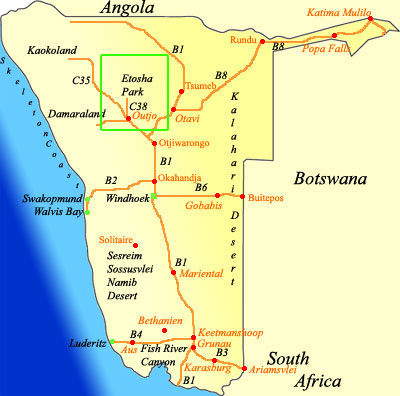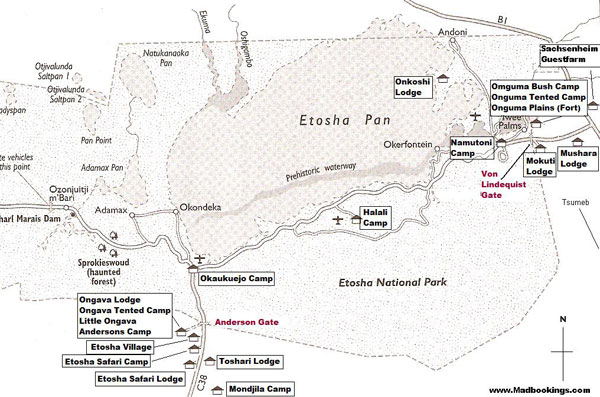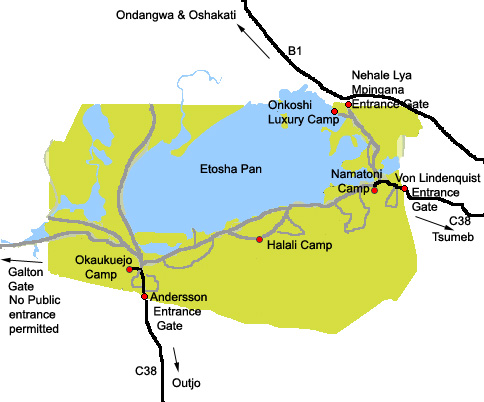Search all Namibia Accommodation
|
Etosha Park AccommodationInside the Park
South West of Etosha
East of Etosha Enter at Von Lindequist Gate
|
Popular places in NamibiaNamib Desert Area Etosha National Park Fish River Canyon Accommodation GuidePlaces to stay around Namibia South Namibia Central Namibia Northern Namibia Coastal Namibia |
Namibia Essential
|
Travel Guide to
|
Etosha Park - Namibia
The Etosha National Park is open all year and daily from sunrise to sunset.
Outside of these hours, visitors either have to be in one of the camps,
or completely outside the park.
For the planning of your trip please keep in mind that the maximum speed
is 60 km/h throughout the park. The roads are untarred, but usually well
maintained, although quite dusty. You do not need a 4x4 for Etosha.
Regarded as one of Africa's greatest wildlife sanctuaries, Etosha National
Park - dominated by its enormous shimmering salt pan - is an area of wild
savannah and open woodland, and is home to a fantastic array of animals.
Despite its arid appearance, the park is packed with an eclectic mix of
familiar faces such as elephant, giraffe, lion, leopard and zebra as well
as the desert specialists like springbok and the iconic gemsbok.
It's also one of the best places in southern Africa to spot the endangered cheetah and black rhino not to mention rare antelope species like black-faced impala, Damara dik dik and roan antelope, plus there's a bird count of 340 species (an interesting blend of savannah, wetland and semi-desert birds).
For such a large wildlife destination Etosha is easy to visit. The main public lodges in the park - Namutoni and Okaukuejo resorts - offer reasonable accommodation and camping but the superb upmarket lodges just outside the park borders offer a far more exclusive and intimate experience.
Etosha National Park Accommodation

Restcamps inside Etosha Park
The Etosha National Park consists of four restcamps.
Okaukuejo, lies about 120 kilometres north of Outjo - on the south-western border of the Etosha saltpan. This is also the main entrance to the Etosha Park with its administration offices. Okaukuejo offers a flood-lit waterhole, where visitors can observe wildlife congregating and interacting day and night. Accommodation is provided to suit every need, in premier bush chalets overlooking the waterhole; bush chalets and double rooms; or family chalets. Other facilities include a restaurant, bar, shop, swimming pool, kiosk and camping facilities. Guided night game drives.
In a former fort of the German Schutztruppe, lies camp Namutoni which is also the eastern access to the park. The camp overlooks the flood-lit King Nehale waterhole. The Fort has been developed into the hub of activity, offering two restaurants, a relaxation lounge, a bar, crafts boutique, curio shop and bookstore. Accommodation is provided in comfortable double rooms or bush chalets. Camping is also available. Guided night drives.
Inbetween, lies the smaller camp Halali, approx. 70 kilometres from both the other camps. One should leave at least a day or two for each of these restcamps to visit the surrounding waterholes. Halali is situated at the base of a dolomite hill, amongst shady Mopane trees. A flood-lit waterhole which is viewed from an elevated vantage point provides exceptional wildlife viewing day and night. Facilities: restaurant, bar, shop, swimming pool, kiosk and camping grounds.
Onkoshi Luxury camp is a relatively new camp. It is nestled on the rim of the pan on a secluded peninsula. Onkoshi was designed as an environmentally friendly establishment with only 15 units (30 beds). No direct access: from Namutoni guests are transported to Onkoshi Camp in vehicles of Namibia Wildlife Resorts. Rooms are built on elevated wooden decks, with thatched roofs, canvas walls and large, wooden-framed retractable doors allowing spectacular panoramic views. Dramatic sunsets and sunrises.
Each restcamp (except Onkoshi) has a petrol station, supermarket, kiosk, restaurant, picnic spot, swimming pool and a waterhole, which is flood-lit after dark. The park offers game drives in the morning, afternoon and at night.
Accommodation in the Restcamps is B&B or DB&B and generally of good quality. Camping is still offered.
 Entry
Gates into Etosha Park
Entry
Gates into Etosha Park
Andersson Gate Located on the south central side of Etosha
99km from Outjo along the C38 Tar road
called Andersson Gate in honour of the explorer Charles Andersson who
teamed with Francis Galton to become the first Europeans to record the
existence of Etosha Pan when they reached Namutoni in 1851.
Von Lindequist Gate is the eastern entrance to the park 113km from Tsumeb along the B1 and C38 . The name is in honour of the Governor of the then German South West Africa who had the foresight to proclaim Etosha a game reserve on 22 March 1907.
A north gate is now open, called the Nehale Lya Mpingana Gate. The gate is named after a king of the former Owamboland. The gate is near Andoni Plains off the B1 road to Ondangwa.
The Galton Gate on the western entrance to the park is not available as an entrance or exit point for the public. The name is in honour of the explorer Francis Galton who was the first European together with Charles Andersson to see the Etosha Pan in 1851.
It's a great place for photography; one's first impression of the park is of a vast expanse of dazzling white pans which, in the harsh light of midday, are painful to look at without sunglasses.
But in the early morning and late afternoons, the pans, through tricks of refracted light, glow and shimmer as they go through an astonishing range of colour changes, from orange through pink and purple to inky, deep blue.
And as for wildlife photography, it's hard to beat Etosha. Not only are there plenty of animals in the park but the lodges have brilliantly designed rows of seating that overlook waterholes which attract jostling crowds of zebra, gemsbok, wildebeest and impala, scattering before herds of impatient elephants or lurking prides of lions.
Head for a waterhole, get comfortable and let the action unfold.
Etosha Pan
The vast, white pan (seasonal lake) was once the biggest lake in the world,
until climate changes dried up the feeder channels and transformed the
vegetation from lush forest into the yellow grasslands of today.
In years of good rains, the pans fill with a food-rich, soupy water that
attracts tens of thousands of wading birds, including huge flocks of flamingos,
covering the strongly alkaline water like a deep pink blanket in the mornings
and evenings.
History
Etosha was first established in 1907, when Namibia was a German colony
known as South West Africa. At the time, the park’s original 100,000
km² (38,500 mile²) made it the largest game reserve in the world.
Due to political changes since its original establishment, the park is
now slightly less than a quarter of its original area, but still remains
a very large and significant area in which wildlife is protected.
Fauna and flora
The Etosha Pan dominates the park. The salt pan desert is roughly 130
km long and as wide as 50 km in places. The salt pan is usually dry, but
fills with water briefly in the summer, when it attracts pelicans and
flamingos in particular. Perennial springs attract a variety of animals
and birds throughout the year, including the endangered Black Rhinoceros
and the endemic Black-faced Impala.
In the dry season, winds blowing across the salt pan pick up saline dust and carry it across the country and out over the southern Atlantic. This salt enrichment provides minerals to the soil downwind of the pan on which some wildlife depends, though the salinity also creates challenges to farming.
A long fence has been erected along the park’s 850 km boundary to control the spreading of disease. The animals concentrate around the new waterholes, resulting in excessive grazing in their vicinity. Fifty waterholes have been constructed to attract animals and so improve the viewing prospect for visitors.
Etosha National Park is one of Southern Africa's finest and most important Game Reserves. Etosha Game park was declared a National Park in 1907 and covering an area of 22 270 square km, it is home to 114 mammal species, 340 bird species, 110 reptile species, 16 amphibian species and, surprisingly, one species of fish. The Etosha Park is one of the first places on any itinerary designed for a holiday in Namibia.
Etosha, meaning "Great White Place", is dominated by a massive mineral pan. The pan is part of the Kalahari Basin, the floor of which was formed around 1000 million years ago. The Etosha Pan covers around 25% of the National Park. The pan was originally a lake fed by the Kunene River. However the course of the river changed thousands of years ago and the lake dried up. The pan now is a large dusty depression of salt and dusty clay which fills only if the rains are heavy and even then only holds water for a short time. This temporary water in the Etosha Pan attracts thousands of wading birds including impressive flocks of flamingos. The perennial springs along the edges of the Etosha Pan draw large concentrations of wildlife and birds.
A San legend about the formation of the Etosha Pan tells of how a village was raided and everyone but the women slaughtered. One woman was so upset about the death of her family she cried until her tears formed a massive lake. When the lake dried up nothing was left apart from a huge white pan.
The game viewing in Etosha National Park is excellent, the best time being from May to September - the cooler months in Namibia. Visitors to Etosha Game Reserve can expect to see many buck species, elephant, giraffe, rhino and lions. More fortunate visitors will see leopard and cheetah. There is a network of roads linking the three campsites and subsidiary roads lead to various waterholes.
When it was originally proclaimed at the turn of the century the Etosha Park consisted of an area of 100,000 square kilometres. This was the largest reserve on earth but in the 1960's political pressure resulted in the Park being reduced to its current size.
Traditionally visitors to Etosha have had a choice of three rest camps - Namutoni, Halali and Okaukuejo. Each camp has tourist facilities such as a restaurant, a shop (selling only basic goods), a motor garage for fuel and basic repairs, and a swimming pool, as well as various grades of accommodation and camping facilities. September 2008 heralded the opening of Onkoshi Camp a brand new lodge inside Etosha - this is the first development inside the park in several decades and looks set to offer an environmentally friendly luxury experience
Non-resident visitors to Etosha, i.e. those residing at one of the many private lodges and hotels around Etosha, can stop off at these camps for rest, recreation, and refueling. All three camps have floodlit waterholes, two of which provide excellent night game viewing. Rhino and elephant are often seen at the waterhole at Okaukuejo, while the newer waterhole at Halali is fast attracting more wildlife. However, Namutoni waterhole is disappointing, probably because there are so many other waterholes in the vicinity.
The dominant vegetation in Etosha is Mopane (Colophospermum mopane) or Omusati in a local language, and it is so widespread in the north-west of Namibia that a region in Owambo is named after it. The western areas of the park support mainly mopane scrub, whereas there are extensive woodlands of tall trees in the southern parts of the Halali area as well as in the camp. One of the most spectacular trees in the park is the African moringa, (Moringa ovalifolia) or ghost tree. There is a specially fenced off area, some 30km west of Okaukuejo, to help preserve this unique and to some, grotesquely shaped trees, known as the haunted forest . This is an unusual habitat for the moringa, as they normally occur on hillsides and they grow in a variety of weird shapes, and as many of the trees have several trunks emerging from a swollen base, they are often mistaken for baobabs, but are not related to them. The second most common species in Etosha is the red bushwillow, (Combretum apiculatum), and is known locally as Kudubusch (German) or koedoebos (Afrikaans), aptly named because kudu and other game species browse the nutritious leaves, whilst rhino consume entire branches and elephant prefer the bark.
Because the quality of accommodation and service is higher at the private establishments, which can be found outside the Etosha Park, visitors often choose to stay in them rather than within the camps. Many of these establishments offer private game drives, either in their own game reserves or in Etosha Park itself.

 Places to stay around
Places to stay around